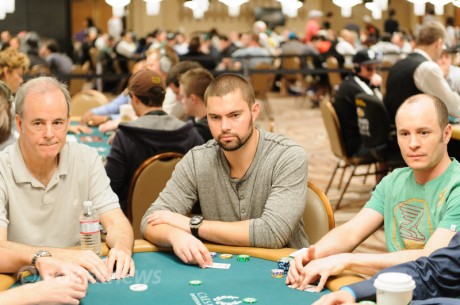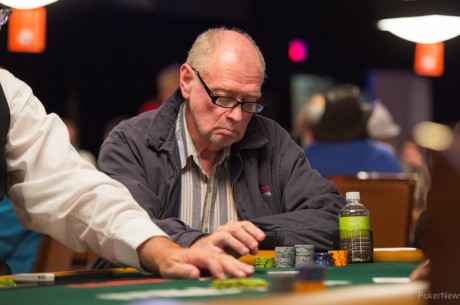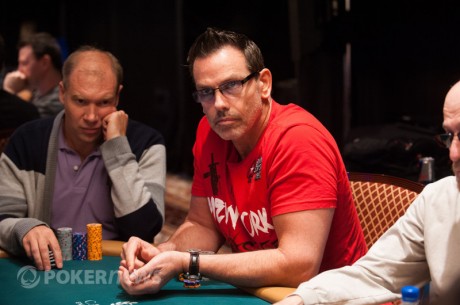Olivier Busquet Discusses His Approach to 2013 WSOP Mixed-Max Event

It was during the 2012 World Series of Poker that the No-Limit Hold��em Mixed Max event made its debut. After its extraordinary popularity in the first run, the WSOP brought it back for a second year, but with a lowered buy-in of $3,000 from $5,000 last summer.
In the Mixed-Max format, the tournament begins nine-handed before transitioning to six-handed on Day 2, and finishes with a heads-up bracket on Day 3. Last year��s winner was Frenchman Aubin Cazals, who earned $480,564 after defeating Joseph Cheong in a heads-up match.
This year, 592 players entered Event #27 in hopes of at least making it to Day 3 to secure a payday and test their skills heads-up for a gold bracelet.
On Friday, we spoke with heads-up specialist Olivier Busquet about the proper tactics needed to run deep in a specialized event such as the mixed-max tournament. He discussed the importance of having skill in heads-up play, isolating and opening ranges, and the weight of aggression in this kind of event.
PokerNews: How do you adjust your aggression for each day going from nine-handed to six-handed to heads-up?
Busquet: It��s pretty straightforward. The less people at a table, the more hands you have to play and the more creative and aggressive you have to be. Other than that, there isn��t necessarily too much strategic adjustment you have to make besides just adjusting to the individual players a table and adjusting your hand ranges accordingly.
How does your opening range vary from each day?
When there are more players then typically you are going to be playing tighter and have a more narrow range. There probably aren��t too many hands that you��re going to raise from early position on Day 1 playing nine-handed that you��re not going to play on Day when it��s six-handed. From an early position point of view when you are six-handed there will be hands that you open like jack-ten off suit, basically any suited ace, and maybe king-eight suit. Whereas, under-the-gun nine-handed you would not open those hands at all. That is where the adjustment comes into play. When playing nine-handed and the first three players fold, then essentially the table becomes six-handed in that instance. So then you would want to adjust because if players are folding hands from early position than they are probably folding hands that are of lower value.
Can you explain the importance of position playing nine-handed compared to six-handed?
Position is just as important. Well actually, six-handed it may be slightly more important just because ranges are wider. When ranges are wider then people are less likely to have strong hands therefore making position a more important factor.
I think the biggest strategic adjustments by far in this tournament come on the third day in regards to moving forward. You may run into some six-handed specialists but that is such a small number to face. There are some players, like me, who just plays heads-up all the time and then there are those that have far less experience in that area. So now if you face a tournament grinder who isn��t used to heads-up strategy compared to someone who specializes in that kind of action, you would adjust accordingly. I��m surprised, actually, at how many tournament players who don��t play heads-up seem content to play in this type of event because being good or being competent in heads-up is incredibly important in this tournament. It��s important because that��s where all the money difference will be, between the final 32 players and first place. So I think people underestimate the importance of being good at heads up is for this specific tournament.
Are suited connectors like 9?8? or suited gappers like 5?7? better for heads-up or are they still strong to play in multi-way pots?
The only thing that I would say is it��s just a question of where you are on the table and how wide you want to play. A bigger factor will be the actual position at your table in regards to who is present, their playing style, their experience level and how many chips they have when you get in a hand with them. That will be a bigger factor when determining how wide your range will be, just in general and not on any specific day. I will play a wider range at a really, soft, and passive nine-handed table than I would at a really tough, reg-heavy, and aggressive six-handed table.
In regards to bluffing, do you see more or less bluffing in the first day than you would on the second day or in heads-up?
I think when you play heads-up you just have to bluff a lot more just because you don��t make many hands and you have to play a lot of hands. The less players you are playing against, then the wider the range you will have and the less likely either you or opponent will have a strong hand, therefore the more you will be bluffing. To be honest though, I think it is a big leak that a lot of tournament grinders have, which is they don��t bluff enough on rivers and bluff too much pre-flop. If they don��t really start to change that, especially when there are fewer players on the table, then that leak will be exposed more and more.
As far as isolating ranges, do you see players isolate early in the tournament or do you see them isolate more when short-handed?
Of course this will be extremely dependent on the situation but I think you are more likely to see players trying to isolate early in tournaments when they found good spots to do so. There are some inexperienced amateurs who just play tons of hands and just don��t play well, especially post flop. So a more experienced player will take advantage of bad play and start to isolate more just to run over the fish of the table. Being aggressive preflop can definitely have its advantage though because if you maintain the same level of aggression, it works towards your favor when you actually do wake up with a hand.
For more strategy advice from the world's top poker players, check out the PokerNews strategy section.








